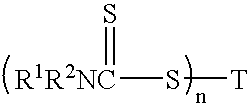Catalytic antioxidants
- Summary
- Abstract
- Description
- Claims
- Application Information
AI Technical Summary
Problems solved by technology
Method used
Image
Examples
example 1
[0213] A test solution was prepared as follows: [0214] 64 mg (0.18 mmole) of Cr(acac)3 was dissolved in 4.8 g (39 mmoles) of deuterated chloroform, with 200 mg (0.83 mmoles) of t-butyl hydroperoxide (3M in iso-octane).
This mixture represents a hydroperoxide:chromium acetylacetonate molar ratio of 4.5 to 1.
[0215] During 95 minutes of heating at 27° C. only about 5% of the hydroperoxide was decomposed to alcohol, as tabulated in Table 2.
TABLE 2Time (minutes)% t-butanol121.9385.4794.4954.9
[0216] Subsequently, during 250 minutes of heating the sample tube of Example 1 at 35° C., 84 percent of the initial hydroperoxide was decomposed by the chromium acetylacetonate. These results are tabulated in Table 3.
TABLE 3Time (minutes)% t-butanol04.91219.94542.57557.510362.515373.618574.424584.5
[0217] An additional 500 mg of TBHP was added to the sample, to test the ability of the Cr(acac)3 to decompose this additional amount. The aggregate ratio of TBHP to Cr(acac)3 then became 15.9. A spe...
example 2
[0219] Repetition of the experiment of Example 1 but with the further addition of up to a final hydroperoxide:chromium acetylacetonate molar ratio of 84:1, shows that the chromium acetylacetonate continues to decompose hydroperoxide to alcohol. Continued activity at the 84:1 ratio indicates that the chromium compound is acting catalytically, rather than stoichiometrically.
[0220] The Cr(acac)3-catalyzed thermal decomposition of t-butyl hydroperoxide was monitored by acquiring spectra at increasing ratios of hydroperoxide to chromium. These results are tabulated in Table 6. After each addition of hydroperoxide, a spectrum was acquired at 27° C. to determine the solution composition. Subsequent to each addition of hydroperoxide, one or more spectra were acquired at elevated temperature to accelerate decomposition. Up through spectrum 26, the high temperature runs were performed at 35° C. Run 27 and later, the high temperature runs were executed at 40° C., to expedite the reaction.
[02...
example 3
[0223] The same heating profile and data acquisition sequence was tested on an aralkyl hydroperoxide (cumene hydroperoxide) to show the generality of the reaction. [0224] 53 mg (0.15 mmole) of Cr(acac)3 was dissolved in 4.0 g (39 mmoles) of deuterated chloroform, with 400 mg (2.6 mmoles) of cumene hydroperoxide (80% technical grade).
This solution gave a hydroperoxide:chromium acetylacetonate molar ratio of 17.2 to 1. The decomposition was monitored by comparing the integrals of the oxygen-bonded carbons of the cumene hydroperoxide and the cumyl alcohol.
[0225] The Cr(acac)3-catalyzed thermal decomposition of cumene hydroperoxide to cumyl alcohol was monitored by acquiring spectra at increasing ratios of hydroperoxide to chromium (as summarized in Table 7). After each addition of hydroperoxide, a spectrum was acquired at 27° C. to determine the solution composition, and then a series of spectra were acquired at 35° C. to monitor the decomposition. Spectra from number 15 and onward ...
PUM
 Login to View More
Login to View More Abstract
Description
Claims
Application Information
 Login to View More
Login to View More - R&D
- Intellectual Property
- Life Sciences
- Materials
- Tech Scout
- Unparalleled Data Quality
- Higher Quality Content
- 60% Fewer Hallucinations
Browse by: Latest US Patents, China's latest patents, Technical Efficacy Thesaurus, Application Domain, Technology Topic, Popular Technical Reports.
© 2025 PatSnap. All rights reserved.Legal|Privacy policy|Modern Slavery Act Transparency Statement|Sitemap|About US| Contact US: help@patsnap.com



